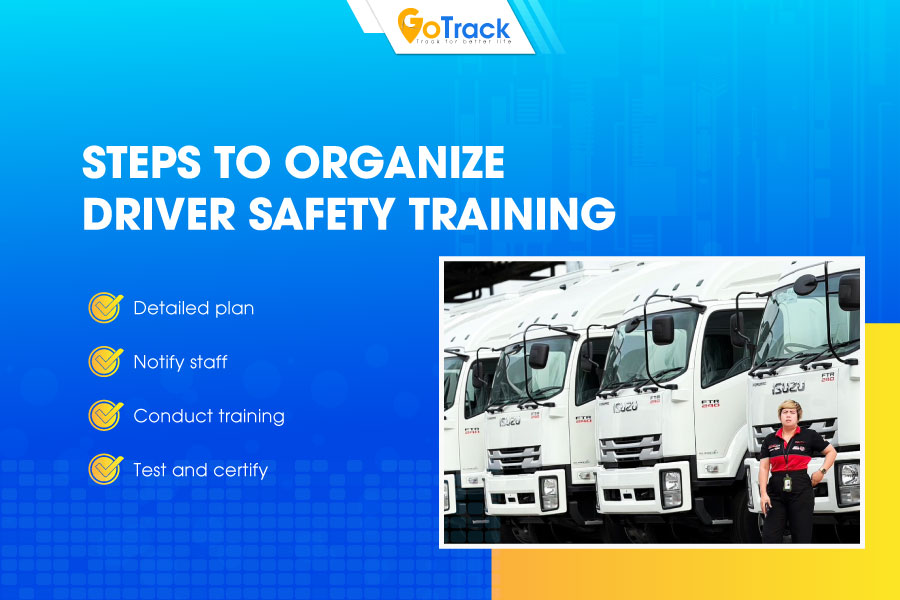For transportation businesses looking to maximize profit and reduce operational costs, investing in a well-trained team of professional drivers with excellent safety driving skills is essential. Drivers who understand and comply with regulations, possess proper driving techniques, and maintain a professional attitude significantly contribute to operational efficiency and business reputation.
In this article, GoTrack will provide you with a comprehensive guide on how to enhance safe driving skills for transport vehicle drivers.
Core training topics to improve driving skills for drivers
Industry knowledge and regulatory compliance
Each country has its own legal requirements for transportation operations. These may include working hour limits, weight restrictions, specific licenses, mandatory GPS tracking systems, and other regulatory frameworks.
It is crucial that all drivers fully understand and comply with these regulations in the countries where they operate. Proper knowledge minimizes the risk of violations that could lead to fines, license suspensions, or legal disputes. Compliance not only protects the company but also reinforces a culture of responsibility among the driving staff.
Safe driving skills
Training in safe driving techniques is fundamental to building and maintaining a high-quality driving team. This training should cover:
- Comprehensive understanding of the vehicle and its systems
- Emergency response techniques
- Maintaining a safe distance from other vehicles
- Collision and accident avoidance strategies
Training should be both theoretical and practical, incorporating real-life driving scenarios across diverse terrains and weather conditions. The goal is to ensure drivers are well-prepared to handle any situation they may encounter on the road.

Handling situations
In the course of their work, drivers will inevitably face various challenges. These can range from road accidents, mechanical failures, passenger disputes, cargo damage, to inspections and enforcement by authorities.
Each scenario requires drivers to respond quickly, appropriately, and with sound judgment. Training in handling transportation-related situations is critical for minimizing downtime, maintaining customer satisfaction, and protecting company assets.
Use of monitoring equipment and software
In modern transportation, tools such as GPS tracking devices, fleet management software, and surveillance cameras are indispensable. Drivers must be proficient in using these technologies to support effective fleet management.
This includes:
- Performing pre-trip checks on monitoring devices
- Recognizing and responding to warning signals
- Proper use of driver identification cards
- Updating trip statuses accurately
- Ensuring real-time data is transmitted to the management system
Proficiency in these tools not only streamlines operations but also provides an added layer of safety and accountability.
Steps to organize training courses to improve driving skills for drivers
Develop a detailed training plan
Before launching a training program, it is vital for the business to create a structured and thorough plan. This plan should include:
- Identifying the number of drivers needing training
- Listing their names and current qualifications
- Determining the timeline, training venue, and method (in-person or virtual)
- Creating detailed lesson schedules
- Assigning or recruiting qualified trainers or instructors
Notify relevant staff
Once the training plan is finalized, it must be communicated clearly to all participating drivers and relevant personnel. This ensures everyone can arrange their schedules to participate without disrupting ongoing operations.
Conduct the training sessions
Execute the training as scheduled, while actively monitoring attendance and engagement. Encouraging drivers to fully participate in both lectures and practical exercises is important for the training to be effective.
Continuous support and supervision during the sessions will help ensure the drivers absorb and retain the knowledge and skills provided.
Test and certify drivers
At the end of the training program, an assessment should be conducted to evaluate the drivers’ understanding and competency. Those who meet the standards should be issued a certificate of completion, if applicable.
Drivers who do not pass the initial assessment should receive additional support and be re-tested after further preparation. This ensures consistency in the quality of drivers across the fleet.
Driver monitoring solutions during operation
Even after completing training, continuous oversight is necessary to ensure that drivers comply with safety standards and maintain professional conduct. Remote supervision tools play a crucial role in ongoing driver management.
Here are key technological solutions that businesses can use:
GPS tracking devices
Certified GPS trackers help monitor the location and route of each vehicle. These devices ensure that the vehicles are being used for the correct purposes and help detect if a driver exceeds speed limits or deviates from planned routes. Managers can take immediate action in case of any irregularities.
Read more: GPS Tracking device GT-S8
In-vehicle cameras
Surveillance cameras help monitor driver behavior, allowing early detection of dangerous actions such as drowsy driving, distracted behavior, or inappropriate conduct. With this insight, the company can intervene promptly and provide additional training if necessary.
RFID driver cards
RFID cards help identify individual drivers and track their work shifts. This ensures that all drivers follow legal driving and rest periods, reducing the risk of fatigue-related incidents.
Fleet management software
Advanced management platforms allow businesses to supervise their fleet operations 24/7. These systems offer real-time data updates, enabling managers to evaluate driver performance and identify areas for improvement. This data-driven approach lays the foundation for strategic training and operational planning.




